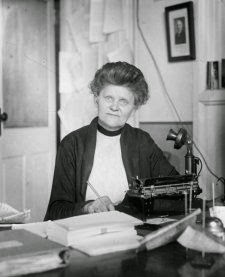Booze & Broads
- Women who made early whiskey were accused of witchcraft. Before whiskey (or whisky in Canada and and Scotland) got it's current name, a distilled mix of fermented grain, herbs and water was called uisge-beatha, the Gaelic term for "water of life." Women in Ireland often created their own recipes for the mix and sold it at markets. It eventually made its way to England, where the demand became so high that it started being produced in larger scales and officially taxed. The English had trouble pronouncing "uisge-beatha", so they began calling it whiskey, and the term was also applied to Scottish distilled-grain spirits. Eventually, many of the women who made and sold whiskey and its unaged cousin, poitín (moonshine's ancestor) were accused of witchcraft, some even burned at the stake.
- Johnnie Walker owes a large amount of its success to a woman. When Elizabeth Cummings' husband, Lewis died in 1872, he left her with three small sons (including one who hadn't yet been born) and a whisky business. Though she could have sold the Cardow distillery and farm, she decided to keep and run the business. She eventually acquired an additional four acres of land and built a new distillery to keep her competitive status in the growing whiskey industry. She sold the Old Cardow distillery to William Grant in 1886. However she kept the new distillery, slowly transferring more and more responsibility to her son, John. In 1892, he was unable to meet the demands of the market, and the Cardow distillery was sold to John Walker & Sons Limited, which later became Johhnie Walker.

Elizabeth Cummings - Prohibition in America surprisingly favored the female. Women who were arrested for illegally producing and or selling alcohol often received lighter sentences than their male counterparts. Further, Women who were suspected of carrying moonshine on their persons were seldom searched because male officers were too "shy" (and in some states legally unable) to frisk women. Many women also had charm on their side and lashes to bat (yay for womanly wiles!). It became clear that female revenue agents were needed, and Miss Georgia Hopley was the first one hired. Her success encouraged various other departments to hire women.

Miss Georgia Hopley - There was only one known female Scotch whiskey distiller during the 20th century. Soon after graduating from Glasgow University, Elizabeth "Bessie" Williamson became a shorthand typist at the Laphroaig distillery. She quickly proved to be an asset and was often asked to manage the distillery when the owner, Ian Hunter, traveled for business. When Ian, who perfected Laphroaig's flavor profile, suffered a stroke in 1938, he asked Williams to take over the U.S. affairs of the business. She took over all of Hunter's responsibilities right before the start of WWII. During the war, the government ceased whiskey production (grains were needed for food instead of whisky) and used the Laphroaig distillery as an armory. However, Bessie prevented them from completely disabling the facility and distributing the whisky there among the soldiers. She also kept the trademarks and other necessary documents current so that after the war was over business could resume. She took ownership of the business and ran it until 1972, converting the preference of many American customers from blended to single malt Scotch in the process.

Elizabeth "Bessie" Williamson - A woman is responsible for the design of the Maker's Mark bottle, label and signature red wax seal. Bill Samuels Sr., a sixth generation whiskey distiller contemplated starting his own brand for years after selling his father's T.W. Samuels distillery. His wife, Marge Samuels eventually told him to "get off his ass" and get to it. She placed two conditions on her blessing for and support of the new venture: it couldn't be like harsh whiskey his father had produced, and she wanted to create the bottle. At that time, most bottles of whiskey looked similar, and she wanted the new product to stand out in both flavor and appearance. French bottles inspired her with their artistry and wax-sealed corks. After many hours and prototypes, Marge created a bottle, label and wax seal that made her proud. She named the product "Maker's Mark" because as a pewter collector, she always searched for the mark of the maker, and she wanted customers to feel like they were purchasing a collectible of sorts. Marge was inducted into the Bourbon Hall of Fame last year.
 |
| Marge and Bill Samuels Sr. |
There are so many more stories of women's contribution to the whiskey world — and the spirits world in general. And these days we're making huge strides toward equality and toward erasing the idea that women can't enjoy (or be) strong, intense spirits. Happy International Women's day. Cheers to you!
*Fine Print: All images are courtesy images. Shoes N Booze is an amazon affiliate, so if you purchase an item here that links to an amazon page.




No comments:
Post a Comment